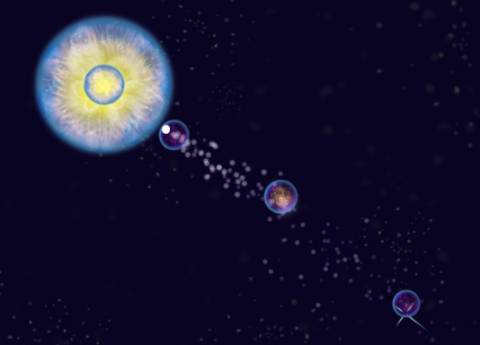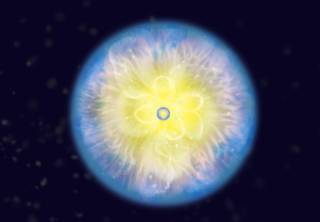Overview
Osmos, developed by independent studio Hemisphere Games, is an ambient strategy game in which the player tries to grow a tiny mote into a large one by absorbing nearby smaller motes. The challenge comes in navigating around other, larger motes in the game world; brush up against them, and the player's own mote will be absorbed. The game was published August 18th, 2009, and is available on a number of game websites, including Steam.
Gameplay
 The player releases matter from the mote to move.
The player releases matter from the mote to move.Gameplay is based upon Issac Newton's Third Law of Motion, that "for every action, there is an equal and opposite reaction."
In order to move, the player must jettison matter from their own mote, pushing them away from the matter they expel. This creates an element of strategy to the game. Release too much, and the player's mote will be too small to absorb anything; release too little, and the mote can't be controlled.
Collisions with other motes will result in a sharing of mass and velocity. For example, two motes of equal size colliding head on will result in a mote that is the combined size of the two originals and completely stationary. If two motes of unequal size collide, the larger mote will absorb mass from the smaller mote, eventually destroying it. The only exception to this rule is the attractor mote, which will consume any non-player motes that collide with it.
Music
The music in Osmos is an ambient, electric-themed collection from the works of the artists Gas/High Skies, Julien Neto and Loscil.
Objects
There are several types of objects in Osmos - called motes - each has its own unique properties.
 The Player's Mote The Player's Mote | The Player The mote over which the player has control. It grows larger as it absorbs and smaller as it releases matter or brushes up against larger motes. |
 The Standard Mote The Standard Mote | The Standard Mote This is the average mote in the game. All motes larger than the player's mote start with a red tint, and, as the player approaches the same size, they turn purple. Eventually, when they can be easily absorbed by the player, they turn bright blue. Standard motes have no mind of their own, but sometimes are given a starting velocity. They either absorb or are absorbed by any motes they encounter. |
 The Antimatter Mote The Antimatter Mote | The Antimatter Mote The Antimatter Mote is different from every other mote in the game. When antimatter motes interact with other regular motes both motes lose size rather than one mote absorbing the other. Antimatter motes will only absorb or be absorbed by other antimatter motes. |
 The Nemocyte The Nemocyte | The Nemocyte The Nemocyte actively seeks to avoid motes larger than itself by releasing matter, just as the player does. If the player seeks to chase it down, the Nemocyte will flee to avoid the player. |
 The Repulsor The Repulsor | The Repulsor The Repulsor moves without expelling matter as same polarity magnets repel one another. It avoids the player at all times, even when it is larger and cannot be absorbed. |
 | The Attractor The Attractor exerts gravitational force on all other motes in the game. The force exerted by the Attractor increases with its size. In the image to the left, the the attractor is a massive body with all other motes, including the player, in orbit around it. |
 | The Ferax The Ferax actively seeks motes smaller than itself and avoids motes larger than itself, including the player. |
|
 The Ovarium The Ovarium | The Ovarium The Ovarium moves slowly and randomly through the field, but otherwise acts like a normal mote. |
|
Awards
Osmos participated in the 2009 Independent Games Festival, and was selected as a finalist for four categories: Excellence in Design, Technical Excellence, the Direct2Drive Vision Award, and the Seumas McNally Grand Prize. It would receive the Direct2Drive Vision Award, as well as later receiving the Best in Show award at IndieCade 2009 and being named one of the PAX 10 at PAX 2009.
System Requirements
PC
- Operating System: Windows XP or Vista
- Processor: 1 GHz
- Memory: 512 MB
- Graphics Card: 3D graphics card with OpenGL support, minimum resolution 800 x 600
- DirectX®: N/A (OpenGL)
- Storage: 33 Mb
- Sound Card: Stereo
Mac
- Operating System: OS X version 10.7 (Lion) or later
SteamOS + Linux
- Operating System: Ubuntu 12.04 LTS, fully updated
- Processor: 1 GHz or faster
- Memory: 512 Mb or more
- Graphics: Hardware accelerated OpenGL support, minimum resolution 800 x 600
- Storage: 40 Mb free space
Log in to comment